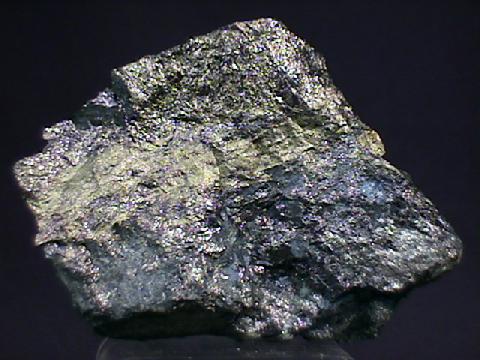Pyrite
From the greek: purites meaning “of fire” or “in fire”
In Ancient roman times this name was used for several types of minerals that would create a spark when struck against steel. Pliny the Elder described one as being brassy and is almost certainly a reference to modern Pyrite (1)
Physical Characteristics
Chemical formula: FeS2
Hardness: 6-6.5
Opaque
Concoidal to uneven fracture, usually no cleavage
Brittle
Luster: metallic
Color: pale brass-yellow, tarnishes darker with iridescence
Streak: greenish black to brownish black
Most pyrite is close to this ideal composition although sometimes Ni or Co can substitute for Fe in small amounts.
Micro-inclusions of gold or chalcopyrite may be present in pyrite as well
Pyrite normally occurs as cubes although it can also form with octahedral faces which are less common and can form in pairs or twins and these are known as “iron crosses”
Pyrite is known as fools gold because it is commonly misidentified as gold, however in my personally experience pyrite has a brighter and shinnier appearance then raw gold which is a duller yellow when raw (in personal experience) Although this might just be a comment on the samples I have seen and not characteristic of pyrite and gold. My mineralogy book literally says :everyone should read Mark Twain’s Roughing It. On this topic. So there you have it, like you needed an excuse to read Mark Twain!
Pyrite is distinguished by hardness brittle fracture, greenish black streak, and from chalcopyrite by the fact that chalcopyrite is a richer yellow and softer.
Occurrence:
Pyrite is the most common sulfide mineral and few hydrothermal are without it. Igneous rocks of almost any composition can have pyrite as well as occurring in metamorphic rocks. Pyrite is also common as fine grains in shale and precipitated from sea water in reducing environments, and coal usually contains some pyrite.
Use:
Pyrite is a source of iron and sulfer and is used as a feedstock in the manufacture of Fe bearing chemicals. Pyrite is usually associated with other economic minerals such as chalcopyrite, galena, and sphalerite. Also gold has been extracted from inclusions within pyrite.
(2)
In the 16th and 17th centuries it was used as a source of ignition for early types of firearms, most notably the wheellock, where the cock held a lump of pyrite against a circular file to strike the sparks needed to fire the gun. (1)
During the early 20th century it was used as a mineral detector in radio receivers and is still used “crystal radio” hobbyists (1)
It is used to make Marcasite Jewelry (which is NOT marcasite) and its made from small faceted pieces of pyrite and is often set in silver and was popular in the Victorian era (1)
environmental impacts of pyrite:
When oxygenated surface water interacts with pyrite, it oxidizes the iron and releases sulfuric acid. This is a natural process that occurs naturally, however, mining and increase groundwater flow into pyrite bearing rocks providing an easy route for this water and thus facilitating the acidification of this groundwater. Older mines in particular have a problem with acidic waters escaping from old portals. This water can be very acidic and carry heavy metals like lead in solution and it poses a real problem when it enters stream systems and can alter ecosystems and be a potential health hazard.
(2)
Metaphysical Properties
Melody (3):
Pyrite can be used as a shield from several forms of negative energy, and simply wearing it activates the shielding and protective aspects. It works on the physical, etheric, and emotional levels.
Pyrite can help keep out the negative vibrations of pollutants on the physical level due to the energy field which it creates within the aura.
Pyrite can inspire the universal energies to activate the nourishing energies of the body, and encourages health intellect and emotional well being.
Pyrite symbolizes the warmth and presence of the sun.
Pyrite can be used to recall of beautiful memories of love and friendship and is also used to help in seeing behind facades and enhance memory and recall of information.
Cunningham (4):
Pyrite
projective energy
planet: mars
element: fire
powers: money, divination, luck
Pyrite was used by ancient Mexicans in polished mirror that may have been used to divine the future, and also placed in American Indian shamans medicine bundles perhaps to lend extra energy. In ancient china pyrite was used to guard against crocodile attacks
Due to its color and shinny-ness its used to draw money and wealth and it is suggested that you can place five pieces of pyrite on your alter and surround them with 5 green cancels light the candles and visualize money coming your way to fulfill your monetary needs…
Pyrite can also be carried to bring money and luck, and the “face” or shinny side can be used as a magic mirror to awaken psychic impulses and carried it is a luck bringer.
Cory at new world witchery also adds that Pyrite is used in hoodoo money drawing spells.


(1) Wikipedia page
(2) Introduction to Mineralogy, by William D. Nesse
(3) Love is in the earth, a kaleidoscope of crystals, by Melody
(4) Cunningham’s encyclopedia of crystal gem and metal magic by scott cunningham








